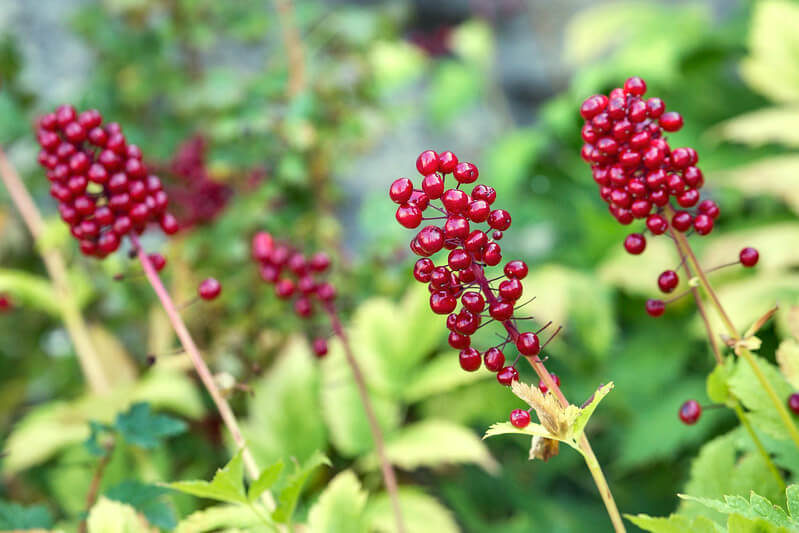Tantalizing Baneberries
by Alyssa Roggow
Broadcast 7.27 & 7.30.2021

Red baneberry. Photo by Neal Herbert/NPS, public domain.
Listen:
I don’t know about you, but it’s not often the word “tantalizing” applies to my existence. Its suggestion of dangerous temptation, of irresistible-yet-unattainable delight, seems a bit melodramatic when applied to the last bowl’s worth of moose tracks ice cream burning a hole in the freezer. A neighborhood 10-year-old once informed me that the disarray of spices, herbs, and teas on a shelf over my sink made me seem like a witch, which, if true, would be the only hint of mysterious danger in my drab, indoorsy life.
But let me tell you about baneberries.
I was in the Rocky Mountain Front last summer picking huckleberries with some friends, their lovable ding-dong of a dog, and a “berry” happy bear who stayed a few steps ahead of us all day but left steaming evidence of his presence for us to find. Lodgepole pines shaded a low carpet of bountiful huckleberry bushes. Dark orbs, some on brazen display, others hiding shyly behind a smooth, oblong leaf, drew us on and on, searching for more. After several hours of collecting berries and stuffing our faces (to no noticeable detriment of the supply), we shouldered our packs and moved on down the trail.

Photo by El Grafo, CC 3.0.
It was then, fresh from the hunt with my heart still turned towards berries, that I saw them. Rising above the thicket on a single stalk was a cluster of red berries. Bright red berries. Glossy red berries that gleamed like a beacon in the shade. Berries that whispered “eat me” in a hue of red so vivid it promised death. I stopped and stared. That red. Into my mind, suddenly blank of everything except those berries, a word dropped like a pebble into a still pool: tantalizing.
The spell was broken when my friend informed me that these were baneberries. Taller than the huckleberry thicket, the baneberry bush stood about waist-high, full of three-lobed, sharply serrated leaves that would cast any self-respecting poison ivy avoider into fits of suspicion. As the name and berries suggest, this plant is poisonous to humans. The pleasant symptoms that will beset you upon eating baneberries include: burning of mouth and throat, severe stomach cramps and diarrhea, headache, dizziness, hallucinations, and, if you are a small child, death. Baneful, indeed. The chemical compounds that cause these reactions remain unknown, but birds are unaffected and eat the berries freely. They are the primary seed dispersers for this plant. I turned away, and we continued our trek behind the elusive bear.
Long after the trip ended, that moment of – what? discovery? temptation? ensorcellment? – stayed with me. Not only the image of the glistening berries themselves, but the word that arrived to describe them: tantalizing. It turns out, the etymology of this word traces back to the Greek myth of Tantalus, a king who tried to steal from the gods. As punishment, he was made to stand in a pool of water up to his neck. Overhead dangled ripe, luminous fruits. When Tantalus reached up to assuage his hunger and thirst, the branches drew away, away, away. He could not eat the fruit.
Fruit! How is it that I, millennia after Tantalus, half a world away in the montane forests of Montana, sweaty and berry-stained, should find myself drawn so powerfully to a fruit that it invokes this specific word? Tantalizing, a word for fruit. I am no witch, despite the neighbor’s opinion of my spice rack, but it seems there are spells of some sort at work here: nature’s power to speak, even through a lowly red berry; and humanity’s imagination in the presence of nature’s power, sharing words and stories across time, cultures, and continents. I don’t know about you, but it makes me want to get outside more and more often.
Every week since 1991, Field Notes has inquired about Montana’s natural history. Field Notes are written by naturalists, students, and listeners about the puzzle-tree bark, eagle talons, woolly aphids, and giant puffballs of Western, Central and Southwestern Montana and aired weekly on Montana Public Radio.
Click here to read and listen to more Field Notes. Field Notes is available as a podcast! Subscribe on iTunes, Google Play, or wherever you listen to podcasts.
Interested in writing a Field Note? Contact Allison De Jong, Field Notes editor, at adejong [at] montananaturalist [dot] org or 406.327.0405.
Want to learn more about our programs as well as fun natural history facts and seasonal phenology? Sign up for our e-newsletter! You can also become a member and get discounts on our programs as well as free reciprocal admission to 300+ science centers in North America!












